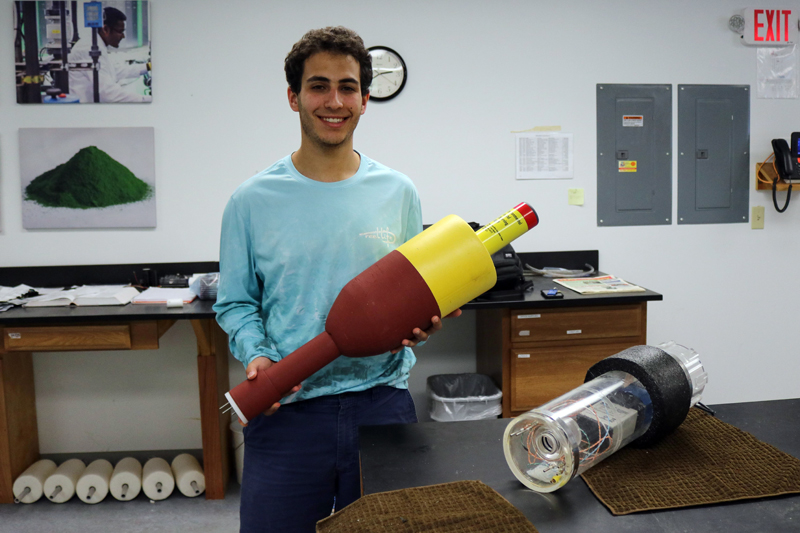
Joshua Girgis shows off a new low-cost environmental monitoring buoy he developed with a team at the Darling Marine Center in Walpole.
University of Maine engineering graduate and intern Joshua Girgis and Dr. Chris Davis, Director of the Maine Aquaculture Innovation Center, teamed up to create an affordable environmental monitoring buoy that oyster and seaweed farmers could use to track conditions on their farms.
Based at the Darling Marine Center in Walpole, the men and a cohort of 30 other interns designed a buoy that would enable these small business owners to have real-time water quality information about where to site their farms and when to put seed oysters and kelp in the water. This buoy, designed to gather information on ocean temperature, salinity, and productivity, also gives fishermen, resource managers, and citizen scientists a new way of gathering fine-scale information about the coastal environment.
An arduous, labor-intensive effort that began in the summer of 2018, the project’s development grew to include a team of UMaine marine sciences and engineering faculty. With support from UMaine’s commercialization program, as well as a number of colleagues throughout the state, they were able to push ahead with the design and develop a watertight buoy, ready for field testing.
In the last 12 months, Girgis led the team’s effort to reduce the cost of the buoy and make it easier to assemble it, using a mix of commercially available and custom-manufactured parts. He also developed the data interface between the buoy and a website that enables farmers to check the conditions where the buoy is in the water. At this point, the price per buoy is just over $2,000, with a monthly operating fee of $7.
With the arrival of COVID-19, Girgis’ work has shifted. He’s working remotely from his family home in Madison and doing what he can to improve the design of the sensors and further lower the price per buoy.
“I’m looking forward to getting back to Walpole when we can safely work onsite again. I’m eager to field test these newest improvements,” said Girgis. “In the meantime, I’m also thinking about where to go next with my education. This project has given me a solid baseline to continue learning. I learned many mechanical and electronics engineering skills and now have the ability to design devices that not only survive but work in the marine environment. That feels good!”
This project was supported by the University of Maine System Research Reinvestment Fund, Maine Aquaculture Innovation Center, Maine Technology Institute, Maine ESPCoR and the U.S. National Science Foundation, and the University of Maine Darling Marine Center.



